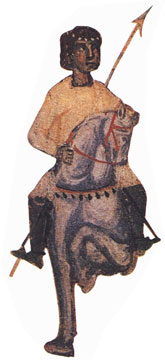Raimbaut de Vaqueiras

Raimbaut de Vaqueiras (also: de Vacqueiras and de Vacqueyras ; * in Vacqueyras , Provence ; † after 1202 ) was a southern French trobador from Vacqueyras in Provence, who mainly worked in Italy.
Coming from the lower Provencal nobility , he was probably sent to the court of the Prince of Orange ( Orange ) before he went into Italian service as one of the first trobadors in southern France. In Italy he made his fortune at the court of Margrave Bonifatius von Montferrat , to whom he, in his own words, served as a 'witness' ( testimoni ), presumably of the count's fame, as a knight ( cavalier ) and as a lecturer at court ( joclar ). If one follows the description in his rhyming letter Valen Marques, Senher de Monferrat , Raimbaut has acquired a kind of privileged position in his entourage, especially through his military services in the operations of the margrave in northern Italy and Sicily.
In 1201 Boniface took part in the Fourth Crusade . Raimbaut was at his side during the siege of Constantinople, no further details are known about him. After the fall of the Byzantine Empire, the margrave was rewarded with the Kingdom of Thessaloniki , which he took possession of in 1205. In 1207 he was ambushed by insurgent Bulgarians and killed with the men in his entourage. Since there is no concrete news about Raimbaut, it has been assumed that he too died on this occasion.
Raimbaut is an important representative of trobadord poetry, who not only mastered the literary repertoire of this poetry, but also expanded it independently. His songs are written in the Occitan poetic language of southern France, which at that time became the guiding language of courtly song poetry at European courts, including the cultural centers of German minstrel , and in Italy not only from immigrant trobadors like Raimbaut, but soon also from Italians as song and poetry language was used.
Among the 26 texts that are ascribed to him today is the music-historically significant Kalenda maia , the rare case of an Occitan dance song based on the melody and shape of an Estampie , which Raimbaut is said to have written after two French minstrels who had traveled to the count's court heard an Estampie fiddling. The famous multilingual court descort Eras quan vey verdeyar also comes from Raimbaut , the five stanzas of which are each written in a different Romance language (Occitan, Italian, French, Gascon, Galician) and are concluded by an accompanying stanza written in all five languages. Furthermore, the pastoral-like bilingual controversial poem Domna, tant vos ai preiada , in which the singer offers himself to a Genoese woman as a lover according to all the rules of courtly art and receives from her a furious rebuff in Genoese (or whatever Raimbaut thought it was). His rhyming letter to the Margrave of Montferrat, mentioned above, is not only a culturally significant testimony to the position of a trobador at an Italian royal court, but also occupies a special place in trobadoresque tradition due to its form - three single- rhymed laissez .
Raimbaut played an important role in conveying the southern French trobadord poetry to Italy - where he also influenced Dante and Petrarch - and in incorporating new Romanesque suggestions into this poetry tradition.
literature
- Klara M. Fassbinder (Ed.): Raimbaut von Vaqueiras. Halle 1929, Reprint Slatkine, Geneva 1977
- Joseph Linskill (Ed.): The Poems of the Troubadour Raimbaut de Vaqueiras. Mouton, The Hague 1964
- Furio Brugnolo: Plurilinguismo e lirica medievale. Bulzoni, Rome 1983
- Dietmar Rieger (ed.): Medieval poetry of France I: Songs of the Trobadors. Provencal / German. Reclam, Stuttgart 1980 (= Universal Library , 7620), pp. 180–187 (No. XXVII: Kalenda maia / Das Maifest , Razo with text of the song and translation), pp. 298f. (Comment)
Web links
- Text of the songs, with English translation
- BEdT - Bibliografia Elettronica dei Trovatori : List of songs and bibliography under PC 392 (Sigle RbVaq )
- Performance , Noemi La Terra & Thierry Cornillon
| personal data | |
|---|---|
| SURNAME | Raimbaut de Vaqueiras |
| ALTERNATIVE NAMES | Raimbaut de Vacqueiras; Raimbaut de Vacqueyras |
| BRIEF DESCRIPTION | Trobador |
| DATE OF BIRTH | 12th Century |
| PLACE OF BIRTH | Vacqueyras , Provence |
| DATE OF DEATH | after 1202 |
